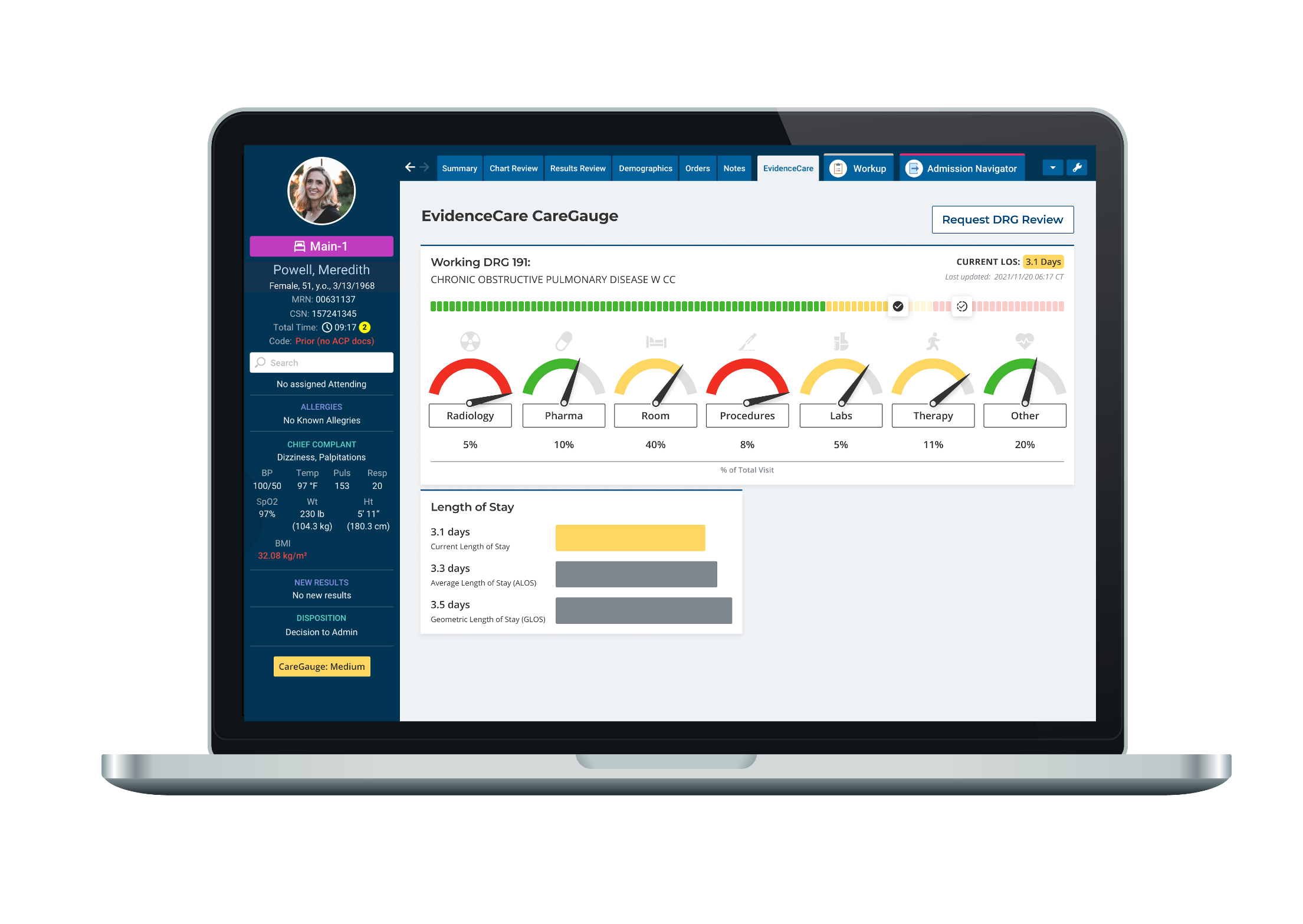Length of Stay Software
In healthcare, “length of stay” (LOS) holds serious significance for healthcare providers, hospitals, and patients. Length of stay, meaning the duration a patient spends within a healthcare facility, is a measure of the time from admission to discharge. The efficiency of this metric can significantly impact both patient outcomes and the operational effectiveness of healthcare providers.
So, why is the length of stay important to hospitals and patients today? It directly influences the utilization of hospital beds, staff workload, and overall resource allocation. Hospitals hope to calculate length of stay optimization to enhance patient satisfaction, improve resource efficiency, and reduce the risk of complications associated with prolonged hospitalization.
Physicians and hospitals aim to optimize patient care and throughput based on length of stay statistics. A shorter length of stay often signifies effective and streamlined processes, ensuring that patients receive the necessary care without unnecessary delays. On the other hand, a prolonged length of stay may indicate potential inefficiencies, leading to increased healthcare costs and a strain on resources.
An unwarranted length of stay variation can add significant cost to a patient’s stay while reducing overall patient satisfaction. Additionally, efficient length of stay management contributes to cost containment, which is always an important consideration in today’s healthcare economics.
Hospitals often employ specialized software to address the issue. Length of stay software is pivotal in analyzing and managing this metric. It helps healthcare providers identify patterns, trends, and variations in length of stay, enabling them to implement targeted strategies for optimization.
By leveraging technology, hospitals can enhance patient care, streamline workflows, and achieve greater operational efficiency, ultimately improving patient and healthcare institutions’ outcomes.
Length of Stay Calculator
Hospitals employ various methods to determine an optimal average length of stay metric. In addition, the Centers for Medicare & Medicaid Services (CMS) uses a standardized approach for length of stay calculation, ensuring consistency and comparability across healthcare institutions. CMS length of stay calculation typically involves the duration from admission to discharge, considering specific patient care episodes.
Several formulas and tools are utilized in the determination of length of stay. A standard method involves subtracting the admission date from the discharge date, providing a straightforward measure of the patient’s time within the facility. This basic length of stay formula is valuable for its simplicity and ease of implementation.
The use of a length of stay calculator further streamlines the process. These tools automate the computation, considering various factors such as weekends and holidays that may influence the overall length of stay. This not only enhances accuracy but also saves valuable time for healthcare professionals.
In addition to these conventional methods, more advanced approaches like the length of stay index calculation and geometric length of stay are gaining traction.
The length of stay index compares the actual length of stay to the expected length, offering insights into the efficiency of healthcare delivery.
Geometric length of stay accounts for variations in patient acuity (or severity of condition), providing a more nuanced perspective on the complexity of cases.
Modern software plays a pivotal role in revolutionizing length of stay calculations. Advanced algorithms and data analytics embedded in length of stay software enable hospitals to efficiently analyze large datasets. This not only facilitates the implementation of CMS LOS calculations but also empowers healthcare providers to identify patterns, trends, and potential areas for optimization. Ultimately, it contributes to improved patient outcomes and operational efficiency in the healthcare ecosystem.
Factors Affecting Length of Stay in Hospital
Many factors influence a patient’s length of stay, and understanding and managing these elements are pivotal for healthcare providers. One significant aspect is the average length of stay by diagnosis, which varies based on the nature and complexity of medical conditions. Analyzing this data allows hospitals to tailor their approaches, allocating resources more effectively and optimizing patient care pathways.
Factors affecting the length of stay in hospitals range from clinical considerations to operational efficiencies. Clinical severity, comorbidities, and the need for specialized interventions contribute to variation in LOS. LOS software can assist in analyzing historical data, identifying patterns in average length of stay by diagnosis, and predicting potential length of stay in hospital for future cases. This predictive capability empowers healthcare providers to proactively plan resources, streamline workflows, and enhance overall patient care.
Potentially preventable length of stay is another critical aspect, representing instances where extended hospitalization could have been avoided with optimized care strategies. Avoidable length of stay refers to situations where patient discharge is delayed due to preventable issues. Inappropriate length of stay occurs when patients are discharged prematurely, leading to potential complications and readmissions. Software solutions are crucial in flagging these instances, providing healthcare professionals with insights to intervene and optimize patient care plans.
The utilization of software in managing these factors goes beyond mere data analysis. It enables hospitals to implement targeted interventions to prevent unnecessary prolonged stays, reduce readmission rates, and enhance overall quality of care. By leveraging advanced algorithms, the software can identify high-risk patients and streamline care coordination, ultimately contributing to a more efficient, patient-centered healthcare system.
Reducing Length of Stay in Hospitals
Reducing the average length of stay in acute care hospitals enhances patient outcomes and contributes to substantial financial benefits and operational improvements. However, the trends for LOS have been going upward.
The American Health Association reports that the average length of stay is up by 19%. Considering that the average American would need to work 384 hours at their job to pay for their hospital stays, there is a clear incentive to reduce the average length of stay. But how can hospitals effectively decrease the length of stay without compromising patient care?
Length of stay software is the answer. Here are some of the benefits of reducing length of stay in hospitals when they actively work to reduce their average length of stay through LOS software.
A decrease in the average length of stay leads to increased bed turnover rates. With patients spending less time in hospital beds, these resources become available for new admissions more quickly, improving overall bed utilization. This operational efficiency is critical for addressing capacity issues and optimizing resource allocation within healthcare facilities.
Financially, the impact is significant. Shorter length of stay results in reduced overall healthcare costs, as resources such as bed occupancy, personnel, and ancillary services are utilized more efficiently. According to statistics from the Agency for Healthcare Research and Quality (AHRQ), each additional day in the hospital can contribute significantly to the overall cost of care, and by reducing the length of stay, hospitals can realize substantial savings.
The reduction in length of stay contributes to a decline in readmission rates. Patients who spend less time in the hospital are less likely to experience complications and require subsequent admissions. This improves patient satisfaction and reduces the financial burden associated with avoidable readmissions.
The financial benefits and operational improvements associated with length of stay reduction in hospitals are evident in enhanced bed turnover, optimized resource utilization, cost savings, and reduced readmission rates. These outcomes underscore the importance of efficient length of stay management for patient well-being and healthcare institutions’ overall sustainability.
Length of Stay Improvement
Reduced hospital stays hold the key to significantly improved patient outcomes and satisfaction, presenting a critical focus area in healthcare management. In fact, the average length of hospital stay in the United States has been a serious subject of analysis and concern. Understanding the consequences of increased length of stay sheds light on the imperative need for improvement in this metric.
Prolonged hospital stays are associated with a range of adverse consequences for patients. These include an elevated risk of hospital-acquired infections, complications related to immobility, and increased exposure to healthcare-associated stressors. The longer a patient remains in the hospital, the higher the likelihood of experiencing these complications, underscoring the importance of efficient length of stay management.
Improved patient outcomes are intricately linked to reductions in the length of hospital stay. Shorter stays minimize the risk of complications, decrease the chances of hospital-acquired infections, and contribute to a more rapid recovery. This is particularly evident in cases where unnecessary delays in treatment or discharge are avoided through the streamlined length of stay management.
Patient satisfaction is another crucial aspect influenced by the length of hospital stay. Extended hospital stays can lead to patient dissatisfaction due to discomfort, disruption of daily routines, and increased stress. Conversely, a well-managed and reduced length of stay contributes to a more positive patient experience, fostering satisfaction and confidence in the healthcare system.
Access to comprehensive hospital length of stay datasets is fundamental for implementing effective improvement strategies. Hospital statistics basics and formulas are essential tools for healthcare professionals to analyze and address the factors influencing length of stay.
By leveraging this data, hospitals can implement targeted interventions, resulting in improved patient outcomes and heightened satisfaction with the healthcare experience. The correlation between a reduced length of stay, enhanced patient outcomes, and increased satisfaction emphasizes the critical role of efficient length of stay management in the continuous pursuit of quality healthcare.
If you’d like to learn more about EvidenceCare’s industry-leading length of stay software, CareGauge, schedule a demo today!










